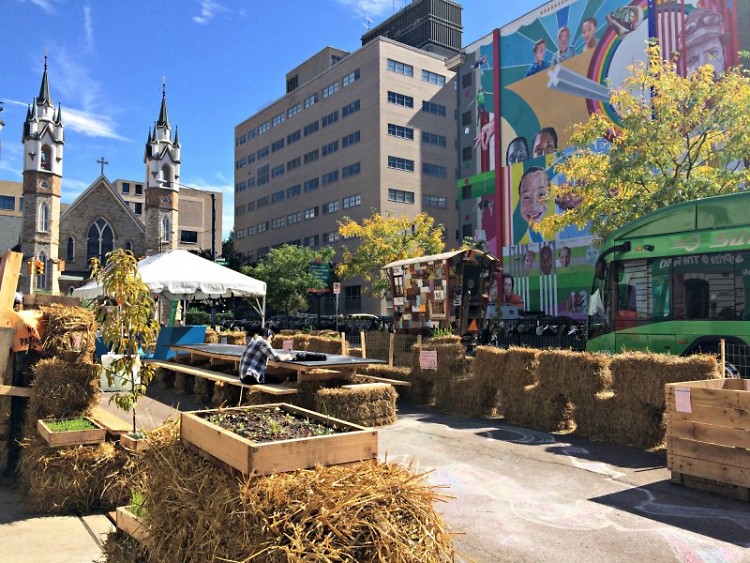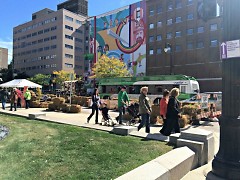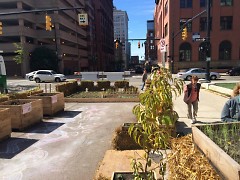Drive through the city to see abandoned lots with a “For Sale” sign, and you are faced with a fascinating conundrum. Inquire from a real estate agency the value of that property and they will de facto respond with its financial value. They may value the property with its worth as a building, a parking lot or green space. But they will likely not respond with its worth with any other metric than one that has a dollar sign attached to it. This popular system of valuation will ignore nearly every other metric that might be used to value an area of land, or at a bare minimum, use its economic value as a proxy. From the nutrient inventory of the soil, to the potential for community-shared meals on the land to the inches of annual rainfall: the economic price tag of a of property is what is used interchangeably with the word value over all others.
Conversely, ask someone to put a price tag on their memories of visiting a park with their late partner, 20 years of meals at a family dining room table or the value of a high-fertility sandy loam to an organic farmer, and you are left with answers that transcend an economy of dollars alone. You begin to enter into an economy that is about ecology, relationships and humanity.
Too often however, the short-sightedness of our financial market economy fails to imagine a metric that transcends the dollar-based valuation system alone.
In our popular consumer economy, we are fairly accustomed to what is referred to as “commodification.” A term used in both economics and industry, commodification is the act of valuing things in their homogenous constituent parts in order to assign them an economic value that can be relatively consistent across the board. An ear of corn grown in South Dakota is worth the same as an ear of corn grown in Nebraska if they will both be fed to a cow in a CAFO in Iowa. A piece of ½” copper sold in California is worth the same whether it was mined in Michigan or Arizona. An hour of time from a janitor in the US is often “valued” approximately the same in the industrialized world regardless of location, save for occasional adjustments for cost of living.
In a globalized era, commodification is the thing that strips something of its story, its individuality and any humanity along its path in order to make it easily sellable or replaceable. We are very accustom to this system because it is what shapes the prices we pay, the decisions we make, and often how we orient our very lives. While we may or may not believe that we surrender to this system of economic valuation on a daily basis, our food system is perhaps the most telling and cautionary tale of the dangers of commodification. And because of this, we often commodify not only the food that we actually eat, but we also the people that grow it, the land from which it comes and even our own bodies’ needs for sustenance.
In 1800, more than 75% of the American population made their income directly or indirectly from agriculture. Today, that percentage is approximately 2%, and less than half of those actually make a living wage from their farm. Though this development in society has left us with nearly formerly incomprehensible amounts of disposable time, our departure from an agrarian ethos has also created an enormous chasm between our capacity to understand what we actually need: food, healthy relationships, clean water, shelter and community; from what we want: food-like product, psuedo-relationships, industrialized water and sewer systems, over-built shelters and often synthetic communities.
David Orr, Chair of Environmental Studies at Oberlin College, argues that because technological innovation has allowed us to exceed our ecological bounds (even just for a time), we actually believe we can forget the extent to which we are truly tied to place. When we have the freedom to drive 500 miles in a day, fly through multiple time zones in one plane, or get completely consumed in an online world while missing the reality in front of us, we can momentarily suspend the fact that our breath and our bodies are daily reliant on clean water, healthy soil, oxygen and the people and places in our lives and regions.
These miracles of modern technology provide an incredible opportunity for engagement and expansion of our minds, while simultaneously creating a false sense of reality for many of us, myself included. This loss of connection to place and location distorts not only our understanding of the complexity of goods we use on a daily basis, but it arguably distorts our very selves as we believe that we are capable of much more than we actually are.
The late Thomas Lyson asserted that what was needed from agriculture was not more innovation or more efficiency, but an increasing movement toward terroir, or a civically-engaged agriculture. Interestingly enough, while the popular discussions of “supporting local” question the fundamental assumptions of commodification, more often than not we avoid an actual interrogation of local and global commodification because of what it might suggest about our own human frailty and need.
That is, we are all vulnerable and in need, but sometimes our financial and material wealth prohibit us from actually seeing that.
Recently, I had the privilege of participating in the design and construction of Kendall College’s third annual “Spark Park.” A pop-up park hosted in conjunction with ArtPrize, (though not formally an entry), it is an exercise in re-imagining a formerly commodified space - a public street - into an interactive and highly engaging space. Replete with outdoor seating and a straw-bale fence filled with plants, a small vegetable garden, yard games and a retro-chic Airstream trailer, this temporary park begged the question, “What actually makes a place a place? And, in this highly vehicle-centric society, is it possible we have forgotten what it is that actually sustains us?”
One need only sit in the literal middle of street on the amazing Trendway furniture surrounded by straw bale gardens and observe the curious and somewhat perplexed drivers that roll by to understand that our system of commodification is a constructed one, and with imagination, it can just as easily be reconstructed into something beautiful.
Over the next year, I hope to explore a number of different facets of the relationship between Urban Agriculture and placemaking. In 2013, I started a small social enterprise to imagine what urban spaces might look like if their potential for healthy relationships between people, communities and the earth were used as a valuation metric rather than the aforementioned rule of a consumer economy alone. Now a small nonprofit, at Urban Roots we believe urban agriculture, while an amazing tool for potentially providing food to all of us who are in desperate need of real food, is also a vehicle for creating and maintaining what many of us long for. We want honest identities that are connected to real places. While our desire for growing food is not only a very real ecological and social need, we are constantly reminded of the words of Mother Theresa, “There is more hunger for love and appreciation in this world than for bread.”
During this year, I plan explore topics that have heavily influenced me and my work including authors like Wendell Berry, Wynona LaDuke, Bill McKibben and topics including resiliency, restorative economies and civic engagement. My hope is not only for abstract arguments and discussions, but about potentially contributing real and tangible growth toward redemption that may happen in this physical space and time.
I look forward to hearing from you, interacting with you and sharing what I have learned during my journey. In my next article, I would like to explore what an ethos of urban agriculture might suggest about building resiliency in our homes, our economies, and our regions.
The Rapidian, a program of the 501(c)3 nonprofit Community Media Center, relies on the community’s support to help cover the cost of training reporters and publishing content.
We need your help.
If each of our readers and content creators who values this community platform help support its creation and maintenance, The Rapidian can continue to educate and facilitate a conversation around issues for years to come.
Please support The Rapidian and make a contribution today.


